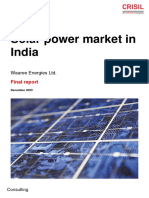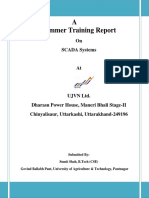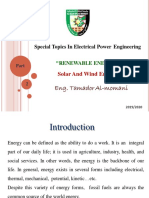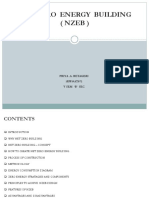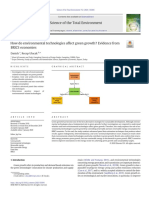1652069147
1652069147
Uploaded by
Shaik SadiqCopyright:
Available Formats
1652069147
1652069147
Uploaded by
Shaik SadiqCopyright
Available Formats
Share this document
Did you find this document useful?
Is this content inappropriate?
Copyright:
Available Formats
1652069147
1652069147
Uploaded by
Shaik SadiqCopyright:
Available Formats
Location of the Proposed Project
Naghtana Village, which is located in Washim District, Maharashtra State, India.
The Problem
Nagthana is a farming village of approximately 150 farms. Each farm is between 1-10 acres.
TOTAL power available to the WHOLE village for ALL electric power needs is only 150,000 kWh
PER YEAR. Nearly 100% of all electric power consumed in Naghtana is transmitted through
the grid and generated by coal-fired power plants.
In order to plant a winter crop when rainfall is scarce (November-February), Naghtana farmers
must rely on coal-fired grid connected power to operate water pumps for irrigation. Because of
the scarcity of electric power in the village, farmers are forced to operate their water pumps in
the middle of the night (1-4AM) when there isn’t much other competition for power. The stress
on farmers of growing crops under these circumstances has contributed to an epidemic of
suicides among farmers.
The Challenge
With the exception of one (1) 6kW solar powered 5HP water pump for irrigation of a 6 acre farm,
Naghtana village has NO renewable energy. Presently the 150 farms in Naghtana village with
water pumps are connected to the grid operated by the Maharashtra State Electricity
Distribution Company Limited (MSEDCL or MahaDiscom). The MahaDiscom power that feeds
Naghtana is fueled by a coal-fired power plant. The scarcity of electric power results in
curtailment of household power of up to six hours per day and curtailment of power to farms of
up to sixteen hours per day.
Type of Project
Sourcing, Installing and Deploying feed-in tariff ready grid connected 6kW solar powered 5HP
water pumps.
Capacity to be Installed
UVS aims to deploy solar water pumps on all 150 farms in Naghtana. At an estimated power
generation of 5000 kWh/year/farm, the total estimated power to be generated by all 150 solar
arrays would be ~750,000 kWh. That amount of solar power would be 5x the total power
currently available for the entire village!
Cost:
The estimated cost per solar water pump is 4-4.8 Lakh.
The Opportunity
With a CSR funding, UVS will be able to facilitate the transformation of farming and other
activities in the village by greatly increasing the supply and reliability of electricity in Naghtana.
For each of those 150 farms to have a solar water pump installed, for the villagers and for
Washim district, Maharashtra state and all of India there will be the following benefits:
A) reduction in GHGs emissions equal to the amount of electric power consumed in the
winter growing season to power water pumps for the participating farms;
B) because each water pump currently is grid connected and India has a feed-in tariff
program, the electric power generated by the solar arrays used to pump water in the
winter growing season can be supplied to the MahaDiscom grid during the 8 months
when the water pumps are not in use. This would both increase the amount of
renewable energy in the system and be a source of additional income to the farmers.
C) in the course of sourcing, installing and operating the CSR funded solar water pumps,
UVS will be able to develop a system for deploying solar water pumps to the other farms
in Washim District.
D) UVS will be able to initiate training of villagers in the installation and operation of solar
water pumps, thus increasing the skills of villagers and seeding new businesses.
E) The villagers will have more power available to them which will raise the standard of
living in the village, as the increased electricity will power more household appliances for
refrigeration, cooking, lighting, communication and education.
Project Description:
UVS and its team of volunteers (the UVS Team) will serve as project manager of the Solar Water Pumps
Project. In this capacity the UVS Team will create a plan to educate and organize the farmers around this
project. The UVS Team will organize meetings or meet individually with village farmers to describe the
project and explain how it will operate. It will determine and oversee all agreements which village
farmers may be required to enter into. These include either master or individual agreements with UVS,
MahaDiscom, EPC contractors, O &M contractors, etc. The UVS Team will write, issue and evaluate the
responses to an RFP from experienced solar water pump contractors for the design, engineering,
procurement, testing and training in the operation of the solar water pumps (the EPC Contract) and their
maintenance (the O & M Contact). The UVS Team also will be responsible for overseeing the
implementation of the EPC contract from execution through the successful operation of the solar water
pumps. In order to create maximum value from this project the UVS Team will undertake to conclude
one or multiple feed-in contract(s) with MahaDiscom. In this regard, the UVS Team will oversee the
establishment of accounting, billing/payment for solar energy generated, consumed and sold by each
farmer’s solar array.
Timeline of Proposed Project:
1. Months 1-6: hold meetings with farmers to familiarize them with the project, describe the
benefits to them and inform them of their obligations under the project. Fashion a
Memorandum of Intent between UVS and participating farmers.
2. Months 1-6: identify EPC candidates, draft and issue RFP for both construction and O & M.
Provide opportunities for EPC contractors to visit the village and evaluate the scope of the
project.
3. Months 1-6: initiate discussions with MahaDiscom about feed-in Tariff program for farmers who
have chosen to participate. Begin to structure an agreement(s) between MahaDiscom and
farmers individually or as a collective.
4. Months 1-6: develop plan to provide a portion of the excess solar energy produced by the
Project’s solar arrays either directly to village households or by increasing MAHADISCOM’s
supply of electric power to the village.
5. Month 7: finalize EPC, O & M and MahaDiscom agreements.
6. Months 7-10: build solar water pump project, including solar arrays, water pumps, electrical
connections, grid connections, metering, etc.
7. Months 10-11: test and troubleshoot the operation of the solar water pump systems.
8. Throughout the 11 month timeline of the project UVS will issue a monthly progress report to all
stakeholders.
Image Caption:Narayan Solanke, pictured in front of his 6kW solar powered, 5HP water
pump which irrigates his 6 acre farm.
You might also like
- Crisil - Report - Solar PowerDocument190 pagesCrisil - Report - Solar Powervijaygawde100% (1)
- Project Report On Solar Power Water Pumping SystemDocument21 pagesProject Report On Solar Power Water Pumping SystemNidhi Bharatiya87% (23)
- Village Energy Concept NoteDocument18 pagesVillage Energy Concept NoteSwarada ChitaleNo ratings yet
- "Solar Power Water Pumping System": A Seminar Report ONDocument24 pages"Solar Power Water Pumping System": A Seminar Report ONtanuj125No ratings yet
- Solar Water PumpDocument22 pagesSolar Water PumpAswini Rout67% (3)
- S.Nandhini 2018001066 (ERG 211 ASSIGNMENT)Document14 pagesS.Nandhini 2018001066 (ERG 211 ASSIGNMENT)erkiruthirajNo ratings yet
- SGP India1Document2 pagesSGP India1Hariprasath VisvanathanNo ratings yet
- Esd Project Report: Solar Water Pumps in IndiaDocument19 pagesEsd Project Report: Solar Water Pumps in Indiamanvi singhNo ratings yet
- Review on Solar Photovoltaic Water PumpiDocument4 pagesReview on Solar Photovoltaic Water PumpiFarzul ArafinNo ratings yet
- Solar Water Pumpimp PDFDocument21 pagesSolar Water Pumpimp PDFArafath AmerNo ratings yet
- Renewable Energy Scenario in India: A Generalised Overview..Document69 pagesRenewable Energy Scenario in India: A Generalised Overview..Ramdhan MeenaNo ratings yet
- Scheme For Solar Pumping Programme For Irrigation and Drinking Water Under Offgrid and Decentralised Solar ApplicationsDocument18 pagesScheme For Solar Pumping Programme For Irrigation and Drinking Water Under Offgrid and Decentralised Solar ApplicationsP.Sang-GeoNo ratings yet
- Summer Training ReportDocument32 pagesSummer Training Reportkrishna_gbpecNo ratings yet
- Solar Water Pumping System For AgricultureDocument2 pagesSolar Water Pumping System For AgriculturePawanJainNo ratings yet
- Solar Mini GridDocument5 pagesSolar Mini GridRoshan ChhetriNo ratings yet
- Mits Poster FinalDocument1 pageMits Poster FinalGajendra AryaNo ratings yet
- Solar Water Pumping System in Isolated Area To Electricity: The Case of Mibirizi Village (Rwanda)Document13 pagesSolar Water Pumping System in Isolated Area To Electricity: The Case of Mibirizi Village (Rwanda)Engr TariqNo ratings yet
- AbstractDocument6 pagesAbstractkwitondafelix2016No ratings yet
- Re Case Study ReportDocument10 pagesRe Case Study ReportBipinNo ratings yet
- Energy in Rural IndiaDocument36 pagesEnergy in Rural IndiarvnesariNo ratings yet
- Chapter 2 RRLDocument11 pagesChapter 2 RRLJess Ivan Ramones100% (1)
- Solar Based Irrigation System: Credit Seminar BY Mohamed A. Orabi 10405Document51 pagesSolar Based Irrigation System: Credit Seminar BY Mohamed A. Orabi 10405Badal NayakNo ratings yet
- Model Scheme On Solar Photovoltaic Pumping System: (For Farmers Without Pumpsets)Document18 pagesModel Scheme On Solar Photovoltaic Pumping System: (For Farmers Without Pumpsets)rajeevme84No ratings yet
- Micro-Hydropower Component Project (MHCPP) Project SummaryDocument6 pagesMicro-Hydropower Component Project (MHCPP) Project SummaryOrodi OdhiamboNo ratings yet
- Solar Micro FinancespeechDocument23 pagesSolar Micro FinancespeechSunil K. SinghNo ratings yet
- Solar Water Pumping SystemDocument9 pagesSolar Water Pumping Systemhuniegetu06No ratings yet
- Solar Pump HandbookDocument212 pagesSolar Pump HandbookMiguelNo ratings yet
- GIIPL ProfileDocument24 pagesGIIPL ProfileShubham JarandeNo ratings yet
- Water Management 2030Document5 pagesWater Management 2030Manuel De Matos MJNo ratings yet
- Case Study Solar Traffic LightDocument15 pagesCase Study Solar Traffic Lightசுந்தர மூர்த்தி சேப்பிளையார்No ratings yet
- Unit 1 Basics of MHPDocument66 pagesUnit 1 Basics of MHPSunil ParajuliNo ratings yet
- 4131-Article Text-7918-1-10-20201227Document10 pages4131-Article Text-7918-1-10-20201227Ain KaloiNo ratings yet
- Solar_Energy_Use_in_Agriculture_for_EnhaDocument10 pagesSolar_Energy_Use_in_Agriculture_for_EnhaFarzul ArafinNo ratings yet
- Chapter One Background of The ProjectDocument56 pagesChapter One Background of The ProjectoluwaseunNo ratings yet
- AGRICULTURE Solar Revolution in AgricultureDocument3 pagesAGRICULTURE Solar Revolution in AgricultureirfanaliNo ratings yet
- Solar Water Pump 3Document24 pagesSolar Water Pump 3abinashbaruah2601No ratings yet
- 10.1515 - Ehs 2023 0127Document20 pages10.1515 - Ehs 2023 0127Utkarsh ShuklaNo ratings yet
- Solar Water Pump ReportDocument25 pagesSolar Water Pump ReportPrajyot06No ratings yet
- Solar Generator ReportDocument26 pagesSolar Generator ReportHasan HemaniNo ratings yet
- Bilgaon DPRDocument29 pagesBilgaon DPRMonilGuptaNo ratings yet
- Solar Photovoltaic Water Pumping System For Irrigation PDFDocument7 pagesSolar Photovoltaic Water Pumping System For Irrigation PDFGUESSOUMA100% (1)
- My Doc SeminarDocument24 pagesMy Doc Seminardeepa bharathiNo ratings yet
- Modelling_of_Solar_Power_Generation_SystDocument6 pagesModelling_of_Solar_Power_Generation_SystFarzul ArafinNo ratings yet
- Solar Irrigation System Using Brush Less DC Motor: Renu Singh, Ahmed Sharique Anees, Devang TyagiDocument5 pagesSolar Irrigation System Using Brush Less DC Motor: Renu Singh, Ahmed Sharique Anees, Devang TyagiEdamEdamNo ratings yet
- Kisan Urja Suraksha Evam Utthaan Mahaabhiyan (KUSUM) Scheme: at PresentDocument4 pagesKisan Urja Suraksha Evam Utthaan Mahaabhiyan (KUSUM) Scheme: at PresentJeffin Emmanuel JoseNo ratings yet
- Solar Energy in PakistanDocument8 pagesSolar Energy in PakistanEngr Dilawar HussainNo ratings yet
- Study of Hydropower Plants of Himachal PradeshDocument65 pagesStudy of Hydropower Plants of Himachal PradeshBhavesh KaushalNo ratings yet
- rrlDocument7 pagesrrlChinee LontocNo ratings yet
- Solar CityDocument3 pagesSolar CityPravat SatpathyNo ratings yet
- Design and Modelling of Hybrid PV-Micro Hydro Power Generation Case Study Jimma ZoneDocument9 pagesDesign and Modelling of Hybrid PV-Micro Hydro Power Generation Case Study Jimma ZoneDanang KimoNo ratings yet
- Proposal of Screw Type Water PumpDocument15 pagesProposal of Screw Type Water PumpMeleseNo ratings yet
- A Review On PV Solar Water Pumping SystemDocument6 pagesA Review On PV Solar Water Pumping SystemIJRASETPublicationsNo ratings yet
- Case Study - SPV Grid - 1Document3 pagesCase Study - SPV Grid - 1Harish BhattNo ratings yet
- Controlled Solar Pump Irrigation SystemDocument60 pagesControlled Solar Pump Irrigation SystemJia JasonNo ratings yet
- Design and Development of Solar Powered Agriculture Water Pump Irrigation SystemDocument11 pagesDesign and Development of Solar Powered Agriculture Water Pump Irrigation SystemAin KaloiNo ratings yet
- Guidelines KUSUM ADocument8 pagesGuidelines KUSUM AKapil MasirkarNo ratings yet
- Electrical Distribution System - Tender FormatDocument8 pagesElectrical Distribution System - Tender FormatDhananjay S. TekawadeNo ratings yet
- r4d Capabilities Solar Powered IrrigationDocument4 pagesr4d Capabilities Solar Powered IrrigationMendrakevNo ratings yet
- Socioeconomic Impact Assessment of the Malalison Island Solar Photovoltaic Hybrid Project in the PhilippinesFrom EverandSocioeconomic Impact Assessment of the Malalison Island Solar Photovoltaic Hybrid Project in the PhilippinesNo ratings yet
- Basic Off-grid & On-grid Design Solar Systems from Scratch: Bonus: Guide to Project Design in Autodesk© Autocad©.From EverandBasic Off-grid & On-grid Design Solar Systems from Scratch: Bonus: Guide to Project Design in Autodesk© Autocad©.Rating: 5 out of 5 stars5/5 (1)
- Unlocking the Power of the Sun Agrivoltaics and Sustainable AgricultureFrom EverandUnlocking the Power of the Sun Agrivoltaics and Sustainable AgricultureNo ratings yet
- Hydrogen GT Readiness White Paper OriginalDocument25 pagesHydrogen GT Readiness White Paper OriginalvarunnarainNo ratings yet
- RE Solar and WindDocument124 pagesRE Solar and WindmohanadymtNo ratings yet
- CV Emise Anul 2022Document147 pagesCV Emise Anul 2022Razvan SomesanNo ratings yet
- Wind Energy JapanDocument10 pagesWind Energy JapanEnergiemediaNo ratings yet
- English Lesson Plans For Grade 7: Lessons in This SectionDocument15 pagesEnglish Lesson Plans For Grade 7: Lessons in This SectionArnel DelossantosNo ratings yet
- Lillian's PresentationDocument18 pagesLillian's PresentationLillian KobusingyeNo ratings yet
- Sc111@gmail - Com FINAL...Document28 pagesSc111@gmail - Com FINAL...Shaurya ChauhanNo ratings yet
- What Drives Energy Consumers?: by Linda Steg, Rachael Shwom, and Thomas DietzDocument9 pagesWhat Drives Energy Consumers?: by Linda Steg, Rachael Shwom, and Thomas DietzVasundhar BoddapatiNo ratings yet
- Equinix,+Inc +2022+Annual+ReportDocument176 pagesEquinix,+Inc +2022+Annual+ReportDaniel ChuaNo ratings yet
- Hand Book - Renewable Energy Master ClassDocument22 pagesHand Book - Renewable Energy Master Classઅનુરુપ સોનીNo ratings yet
- Net Zero Energy Building (Nzeb) : Priya .A. Betageri 1RW19AT072 V Sem B' SecDocument10 pagesNet Zero Energy Building (Nzeb) : Priya .A. Betageri 1RW19AT072 V Sem B' SecIMRAN KHANNo ratings yet
- Wind Mill ReportDocument51 pagesWind Mill ReportMANIKANDAN B.No ratings yet
- Electrical Engineering: Rajiv Gandhi College of Engineering and ResearchDocument10 pagesElectrical Engineering: Rajiv Gandhi College of Engineering and Researchnitesh_khandare7703No ratings yet
- Dellner Sustainability Annual Report - 2022 - ENGDocument26 pagesDellner Sustainability Annual Report - 2022 - ENGShrey ShivamNo ratings yet
- Community Emergency Preparedness Committee ReportDocument46 pagesCommunity Emergency Preparedness Committee ReportIvan HerreraNo ratings yet
- PR G4 Di Pa Final Maybe 3Document21 pagesPR G4 Di Pa Final Maybe 3emaildisposable928No ratings yet
- The Ghanaian Green EconomyDocument2 pagesThe Ghanaian Green EconomyDaniel TackieNo ratings yet
- 2023-Module 6-Compensation Package Design and Justification AssessmentDocument9 pages2023-Module 6-Compensation Package Design and Justification AssessmentAnthony Christian BalceNo ratings yet
- Roadmap For Smart Grids and Electricity SystemsDocument32 pagesRoadmap For Smart Grids and Electricity Systemsissam sayyafNo ratings yet
- Baran Energy Ecosystem Project - Baran EnergyDocument12 pagesBaran Energy Ecosystem Project - Baran EnergyAgungSetya100% (2)
- Exergy Analysis of Biomass Organic Rankine Cycle For Power GenerationDocument8 pagesExergy Analysis of Biomass Organic Rankine Cycle For Power Generationsergio matomaNo ratings yet
- Wind & Solar EnergyDocument8 pagesWind & Solar EnergyGayashan KulathungaNo ratings yet
- Crossing OverDocument197 pagesCrossing OverHectorNo ratings yet
- Science of The Total Environment: Danish, Recep UlucakDocument7 pagesScience of The Total Environment: Danish, Recep UlucakMarcela JaimesNo ratings yet
- Sci 7 Long Test and 4TH Periodical Test 4TH With TosDocument6 pagesSci 7 Long Test and 4TH Periodical Test 4TH With TosRochelle VilelaNo ratings yet
- Recommendations for Tesla in Line with SDG 12Document3 pagesRecommendations for Tesla in Line with SDG 12tawfikdodo14No ratings yet
- Res Unit VDocument12 pagesRes Unit VReeshma.GogulaNo ratings yet
- English Solar Farm Proposal by TSF Oct 123Document38 pagesEnglish Solar Farm Proposal by TSF Oct 123Atiqah HamzahNo ratings yet
- HydropowerDocument148 pagesHydropowerkabira12100% (2)
